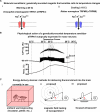Optogenetics and thermogenetics: technologies for controlling the activity of targeted cells within intact neural circuits
- PMID: 22119320
- PMCID: PMC3292652
- DOI: 10.1016/j.conb.2011.10.023
Optogenetics and thermogenetics: technologies for controlling the activity of targeted cells within intact neural circuits
Abstract
In recent years, interest has grown in the ability to manipulate, in a temporally precise fashion, the electrical activity of specific neurons embedded within densely wired brain circuits, in order to reveal how specific neurons subserve behaviors and neural computations, and to open up new horizons on the clinical treatment of brain disorders. Technologies that enable temporally precise control of electrical activity of specific neurons, and not these neurons' neighbors-whose cell bodies or processes might be just tens to hundreds of nanometers away-must involve two components. First, they require as a trigger a transient pulse of energy that supports the temporal precision of the control. Second, they require a molecular sensitizer that can be expressed in specific neurons and which renders those neurons specifically responsive to the triggering energy delivered. Optogenetic tools, such as microbial opsins, can be used to activate or silence neural activity with brief pulses of light. Thermogenetic tools, such as thermosensitive TRP channels, can be used to drive neural activity downstream of increases or decreases in temperature. We here discuss the principles underlying the operation of these two recently developed, but widely used, toolboxes, as well as the directions being taken in the use and improvement of these toolboxes.
Copyright © 2011 Elsevier Ltd. All rights reserved.
Figures


References
-
- Cohen MR, Newsome WT. What electrical microstimulation has revealed about the neural basis of cognition. Curr Opin Neurobiol. 2004;14:169–177. - PubMed
-
- Penfield W, Rasmussen T. The Cerebral Cortex of Man: A Clinical Study of Localization of Function. Macmillian; 1950.
-
- Limousin P, Krack P, Pollak P, Benazzouz A, Ardouin C, Hoffmann D, Benabid AL. Electrical stimulation of the subthalamic nucleus in advanced Parkinson's disease. N Engl J Med. 1998;339:1105–1111. - PubMed
-
- Nitsche MA, Paulus W. Sustained excitability elevations induced by transcranial DC motor cortex stimulation in humans. Neurology. 2001;57:1899–1901. - PubMed
-
- Barker AT, Jalinous R, Freeston IL. Non-invasive magnetic stimulation of human motor cortex. Lancet. 1985;1:1106–1107. - PubMed
Publication types
MeSH terms
Grants and funding
- R01MH094721/MH/NIMH NIH HHS/United States
- R01 DA029639/DA/NIDA NIH HHS/United States
- RC1 MH088182/MH/NIMH NIH HHS/United States
- 1R01NS075421/NS/NINDS NIH HHS/United States
- DP2 OD002002/OD/NIH HHS/United States
- P01 NS044232/NS/NINDS NIH HHS/United States
- R01 MH094721/MH/NIMH NIH HHS/United States
- 1R43NS070453/NS/NINDS NIH HHS/United States
- R01 NS075421/NS/NINDS NIH HHS/United States
- R01 NS067199/NS/NINDS NIH HHS/United States
- DP2OD002002/OD/NIH HHS/United States
- RC2 DE020919/DE/NIDCR NIH HHS/United States
- 1RC1MH088182/MH/NIMH NIH HHS/United States
- 1R01DA029639/DA/NIDA NIH HHS/United States
- R43 NS070453/NS/NINDS NIH HHS/United States
- 1R01NS067199/NS/NINDS NIH HHS/United States
- 1RC2DE020919/DE/NIDCR NIH HHS/United States
LinkOut - more resources
Full Text Sources
Other Literature Sources

